Ghost of Tsushima review – sword of doom
T3's official Ghost of Tsushima review discusses the bloody and beautiful samurai epic

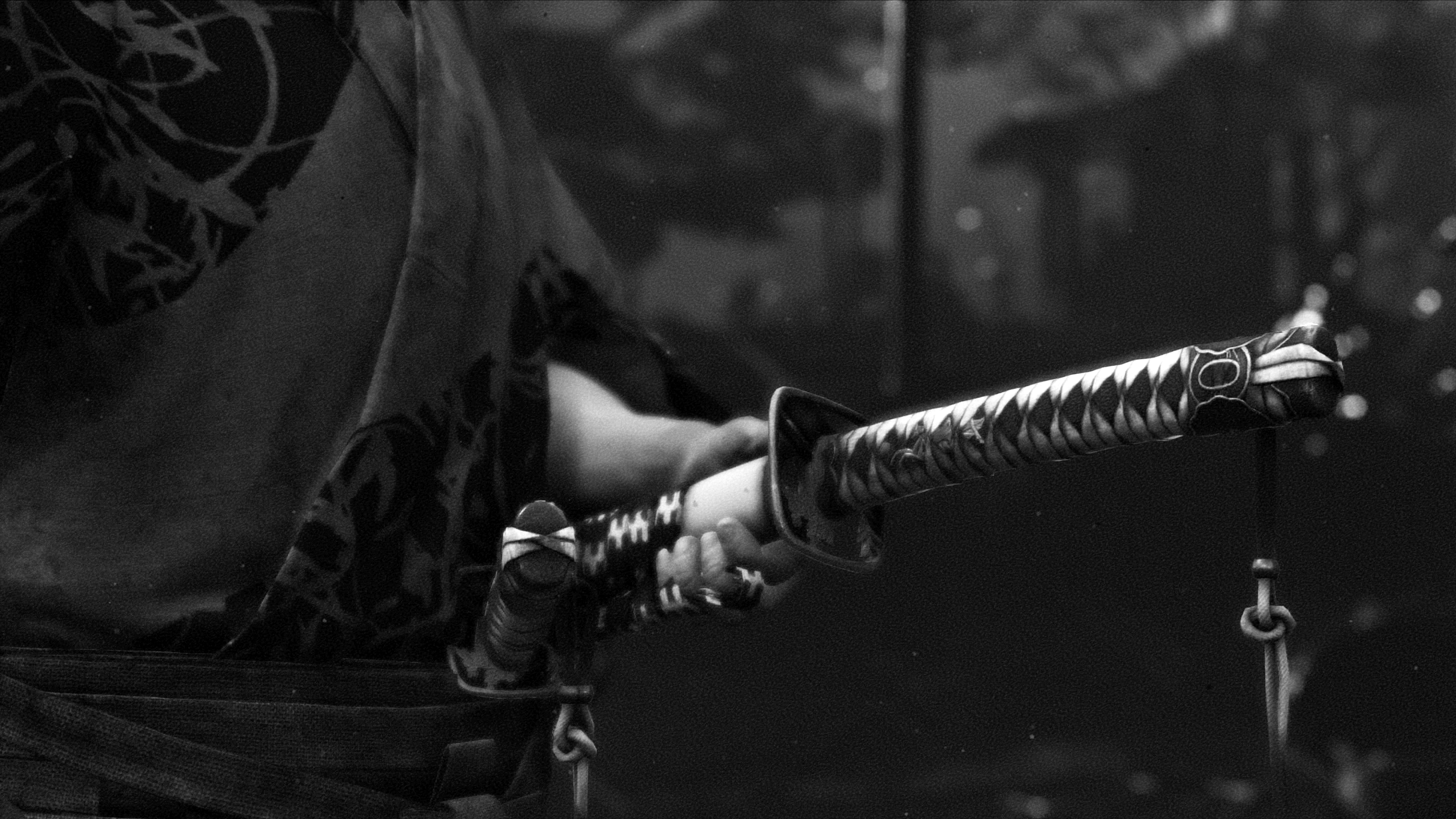
Ghost of Tsushima is a beautiful, well-crafted samurai epic that weaves addictive open world gameplay into a series of narratives that pay homage to classical Japanese jidaigeki. In the game you live and die by the sword, with a bloody and brutal end for you or your enemies frequently mere moments away. Like the Hagakure teaches, though, it is only by embracing death that you can conquer fear and become the hero Tsushima needs.
-
+
Complex and rewarding combat
-
+
A visual tour de force
-
+
Strong customisation options
-
+
Immersive soundscape and music
-
+
Kurosawa and photo modes are superb
-
+
Strong plot and cast of characters
-
+
It's like playing a Japanese jidaigeki
-
-
A side-quest glitched out on me and couldn't be completed
-
-
Not as forgiving as typical AAA games
Why you can trust T3

Welcome to T3's official Ghost of Tsushima review. Over the past few weeks I have been playing the new title from Sucker Punch and what follows is my considered take.
And, simply put, I had insanely high hopes for Ghost of Tsushima and had been waiting with bated breadth for the game for years. This was because, as you can see from the image below, I am a long-term fan of Japanese jidaigeki and, specifically, the samurai movies of the great Akira Kurosawa, Kihachi Okamoto and Masaki Kobayashi.
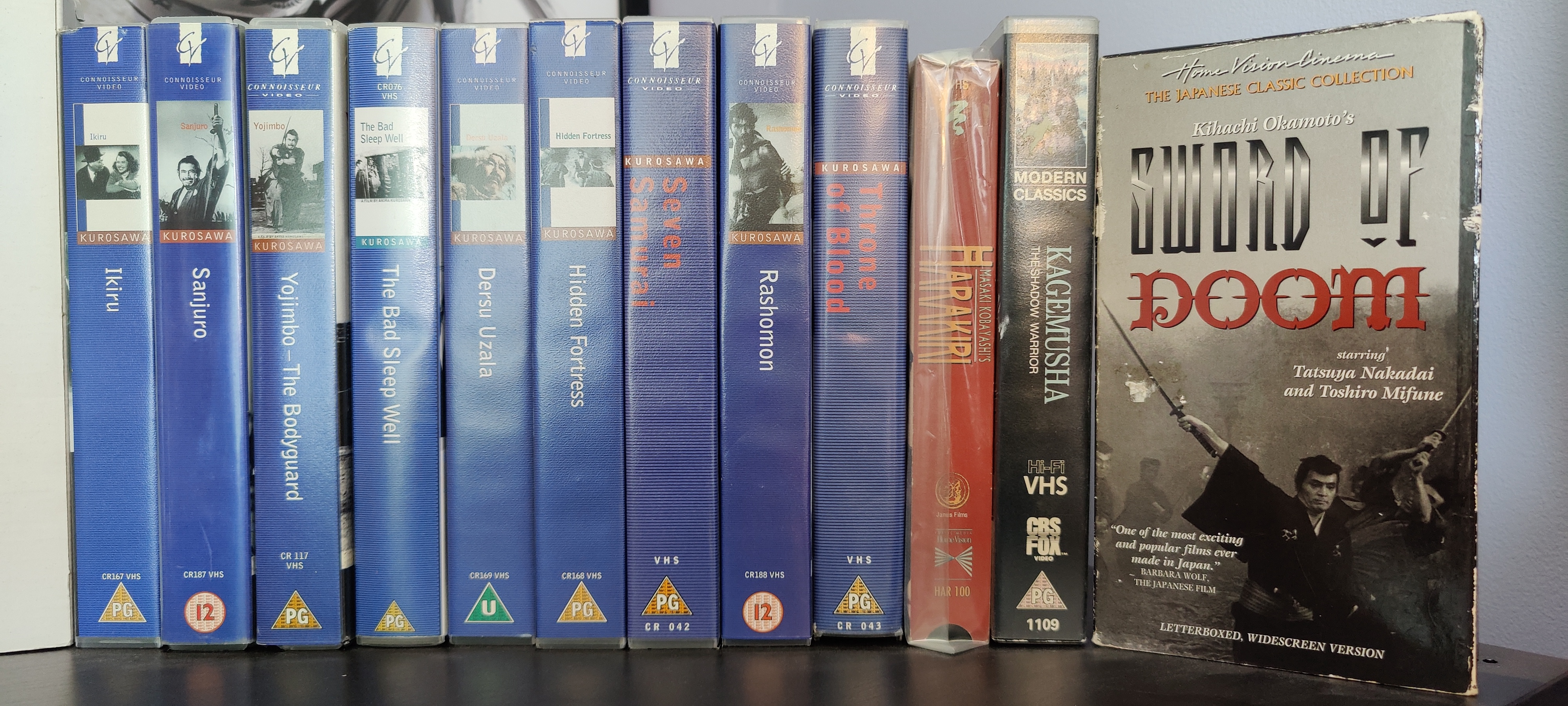
I am a huge jidaigeki and Akira Kurosawa fan, so I had very high hopes for Ghost of Tsushima.
Disclaimer: Kurosawa mode
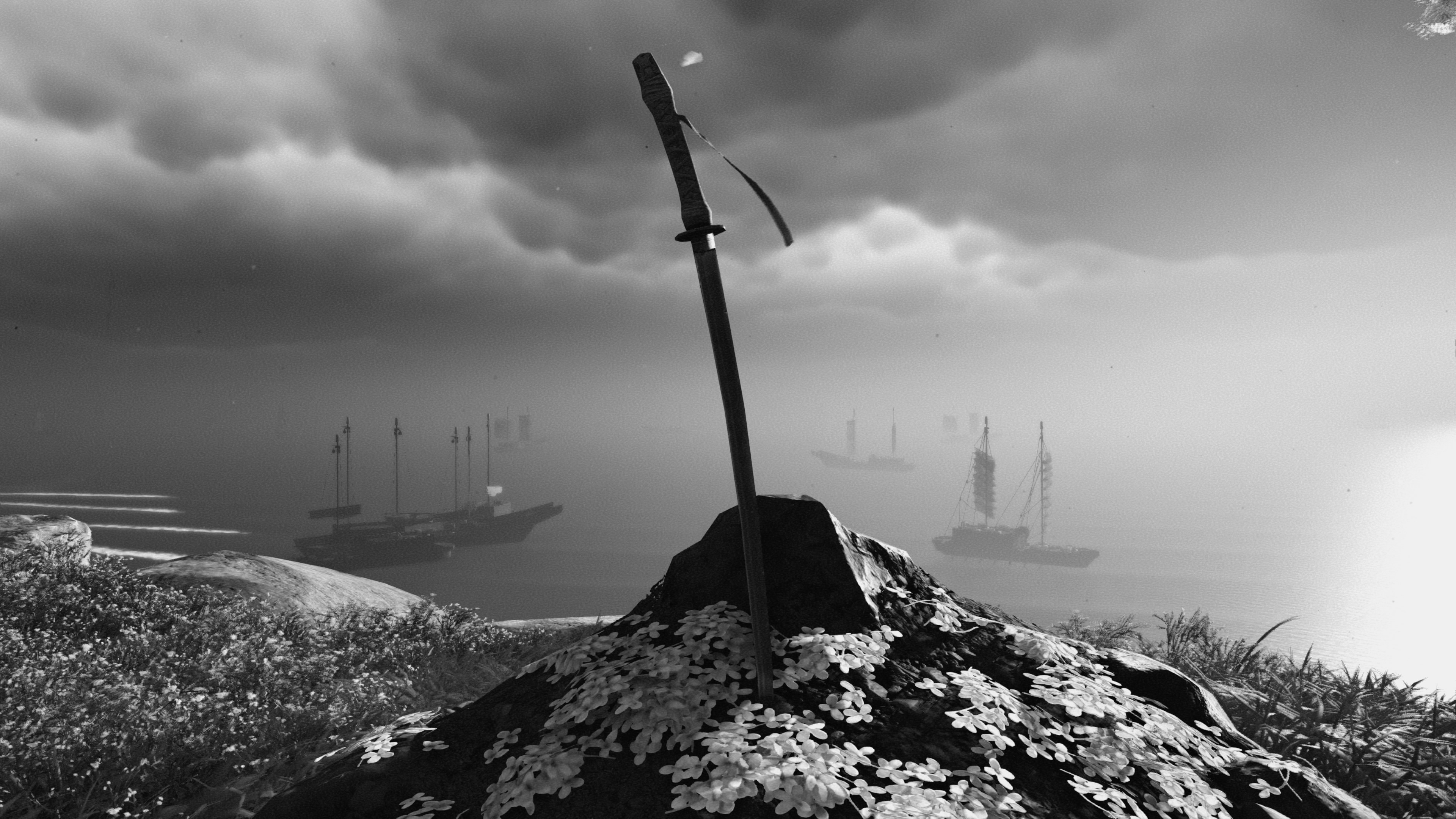
Ghost of Tsushima can be played in what is called "Kurosawa mode". In this mode the game's visuals are transformed from full colour to black and white, with a old-fashioned film filter also overlayed. This option can be selected right from the off and, as a huge fan of Akira Kurosawa's movies, this is how I have played the game. Naturally, if you prefer a full-colour experience, then you can indeed play Ghost of Tsushima that way. The game is also playable with both Japanese (with subtitles) and English voices – for the full jidaigeki experience I selected Japanese.
I've also read the Hagakure (The Book of the Samurai) and The Book of Five Rings, the latter written by legendary Japanese swordsman and rōnin Miyamoto Musashi.
Basically, this game seemed designed specifically for me and my tastes, and so the anticipation was sky high. And especially so considering that it could of been a big disappointment, which for me at least would of left a lingering bad taste in the mouth of this current console generation, which is so rapidly drawing to a close.
The truth is, though, Ghost of Tsushima is a masterpiece. It is one of, if not the, best games of this generation, delivering a beautifully authentic virtual world to explore, a complex but rewarding combat system, and plenty of customisation options that are sure to lead to hours of gaming joy.
The game recreates the feeling of being a samurai or rōnin like no other
Most importantly, though, the game recreates the feeling of being a samurai or rōnin like no other that has come before it. It is empowering and thought provoking, with authentic detail and philosophical musings sitting at its core.
To discover exactly how the game manages to do this in greater detail then keep reading, with my full Ghost of Tsushima review following the title's official trailer and pricing and availability information.
Get all the latest news, reviews, deals and buying guides on gorgeous tech, home and active products from the T3 experts
Ghost of Tsushima review: video trailer
Ghost of Tsushima review: price, release date and editions
Ghost of Tsushima releases on July 17, 2020, and is available from all good game stores.
Ghost of Tsushima comes in a variety of editions. The standard edition, pricing for which can be seen below, delivers the game with some digital pre-order bonuses.
There is also a Ghost of Tsushima Special Edition. This version of the game comes with a Steelbook as well as the following digital items:
Mini art book, Director's commentary, Hero of Tsushima skin set (Golden Mask and Sword Kit), 1 Technique Point, Charm of Hachiman's Favor
Moving up in terms of price further is the Ghost of Tsushima Digital Deluxe Edition. This package includes:
Mini art book, PS4 Samurai Dynamic Theme, Director's commentary, Hero of Tsushima skin set (Golden Mask, Body Armour, Sword Kit, Horse, Saddle), 1 Technique Point, Charm of Hachiman's Favor
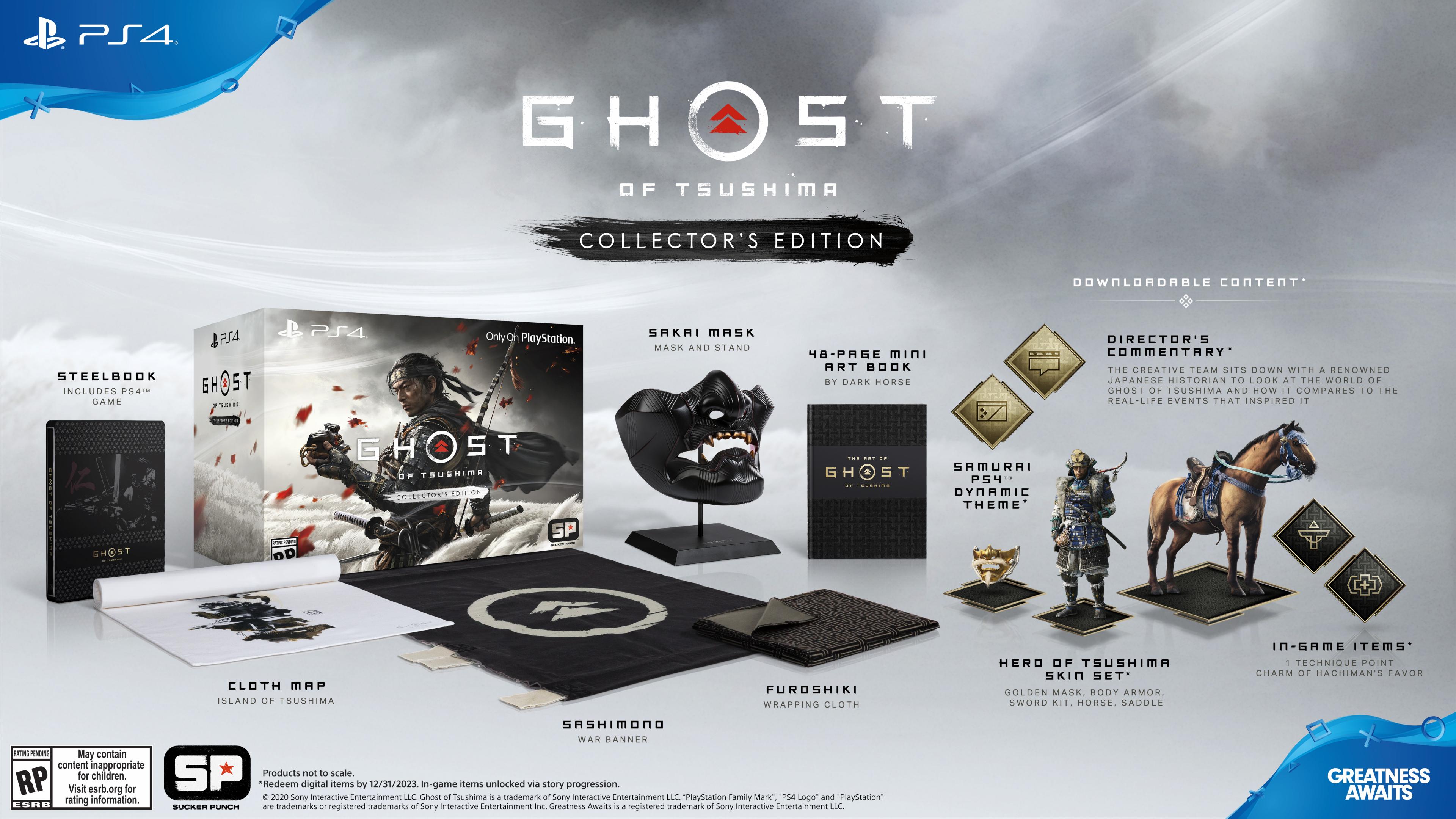
The Collector's Edition of Ghost of Tsushima includes plenty of physical goodies.
And, finally, there is the Ghost of Tsushima Collector's Edition, which comes with everything shown off in the above image.
This version is the most expensive as it includes all the digital content as well as selection of physical items, including a Sakai mask and stand, cloth map, sashimono war banner, 48-page art book and furoshiki wrapping cloth.
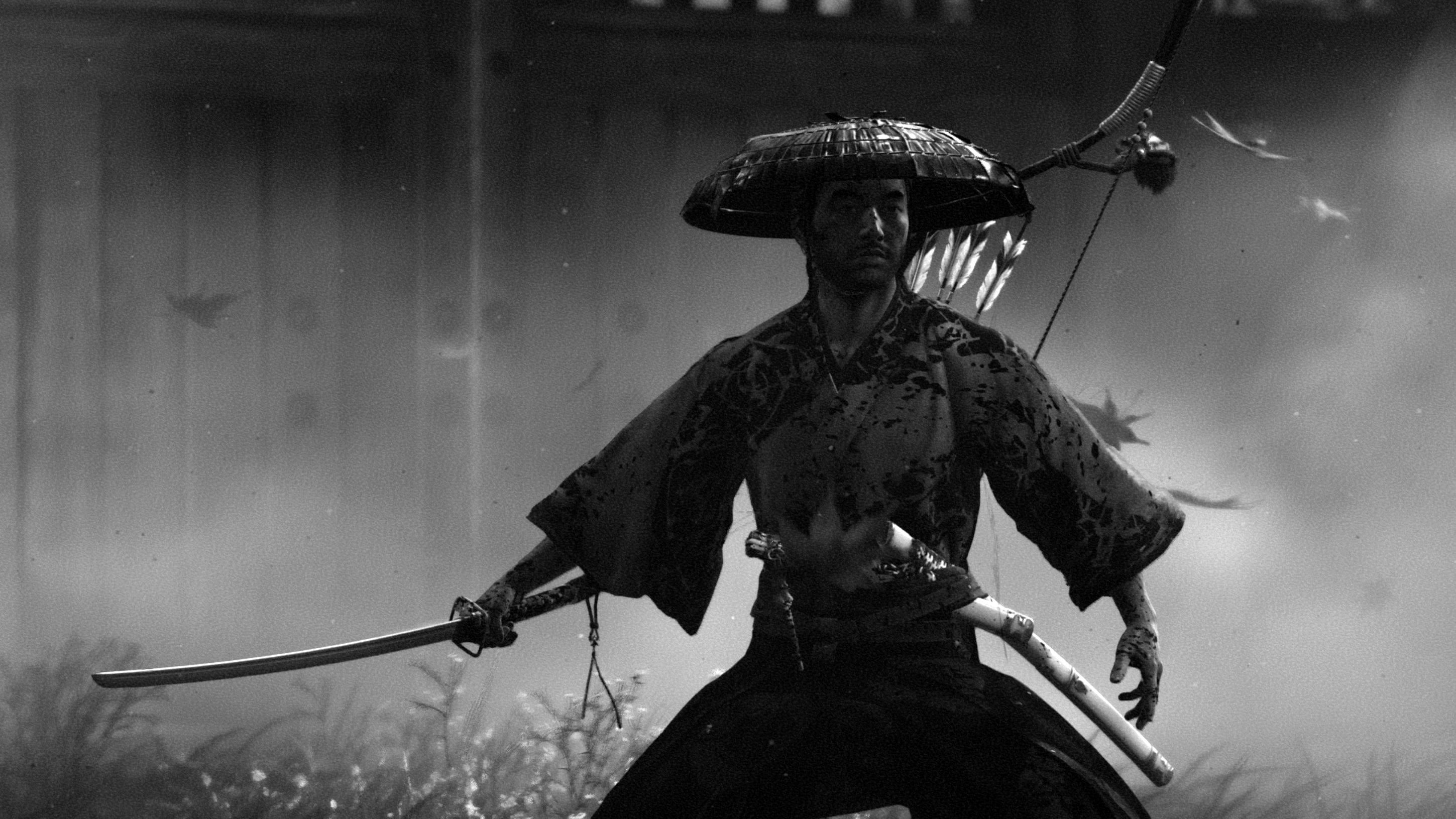
The cinematography is continuously reminiscent of Japanese jidaigeki, and especially the works of Akira Kurosawa.
Ghost of Tsushima review: plot and characters
In Ghost of Tsushima you play samurai Jin Sakai during the first Mongol invasion of Japan. This was a real-world event and it is from that which Sucker Punch spins out the game's tale, with vast Mongol armies invading the island with an aim to conquer it and then Japan in its entirety.
The game's big bad is Mongol leader Khotun Khan, who we discover is cousin of the famous real-world Kublai Khan, yes he who's stately pleasure dome Samuel Taylor Coleridge once dreamt of. A large, imposing presence, Khotun is never too far away from the game's main story and is interesting as he acts as a counterpoint in terms of culture and philosophy to the Japanese warrior mindset that Jin holds.
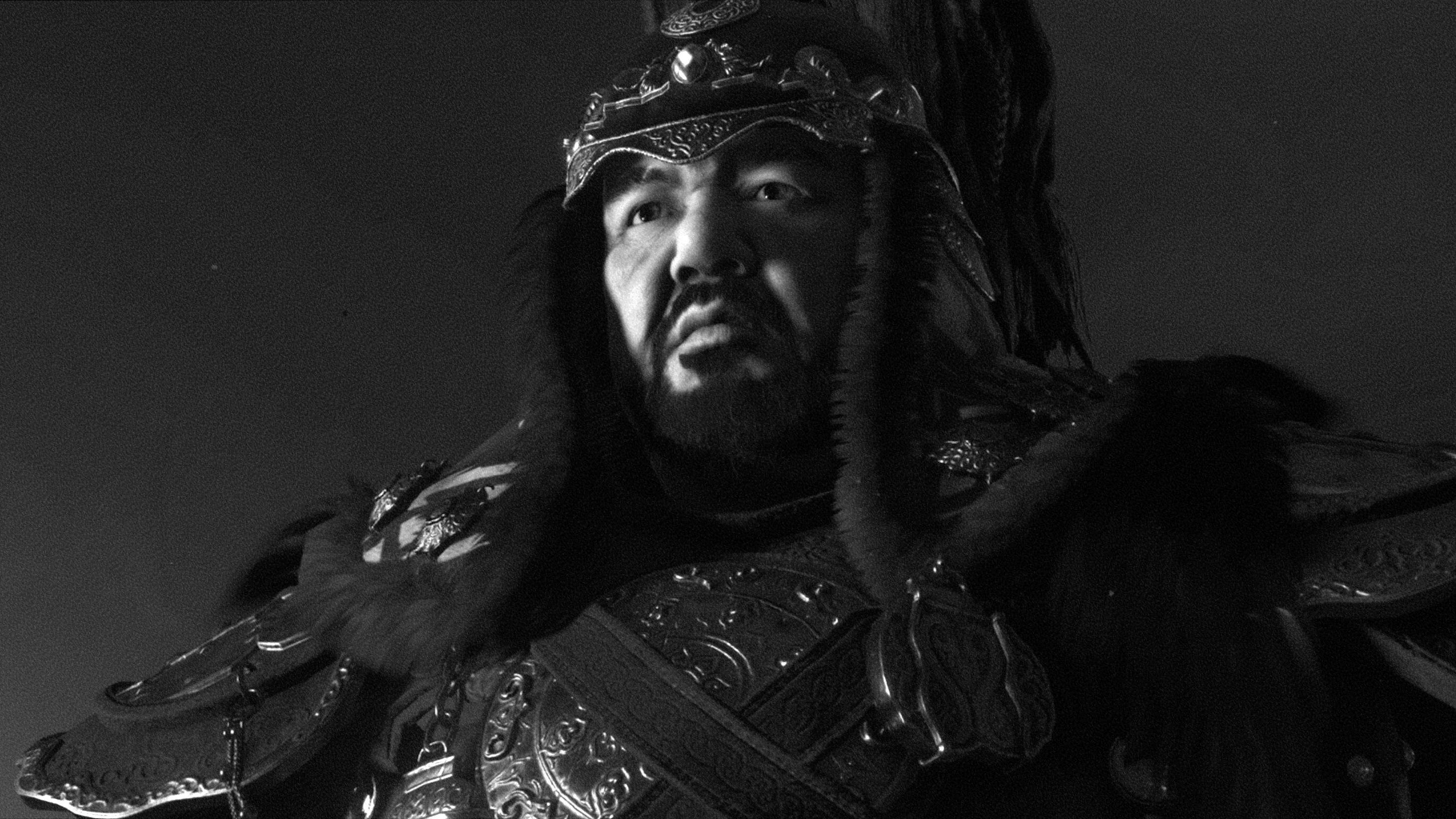
The game's big bad, Mongol leader Khotun Khan.
Jin's history is told in the game via a series of historical cut scenes and interactive set pieces, which is smart as it helps introduce characters and their relationships prior to the Mongol invasion. Understanding where Jin comes from is central to his evolution and actions in Ghost of Tsushima.
Other notable characters include Jin's close companion Masako (a samurai) Ippei (a warrior monk) and his sensei Ishikawa, which act both from personal motivations as well as a wider sense of duty to defend Tsushima and Japan from the Mongols.
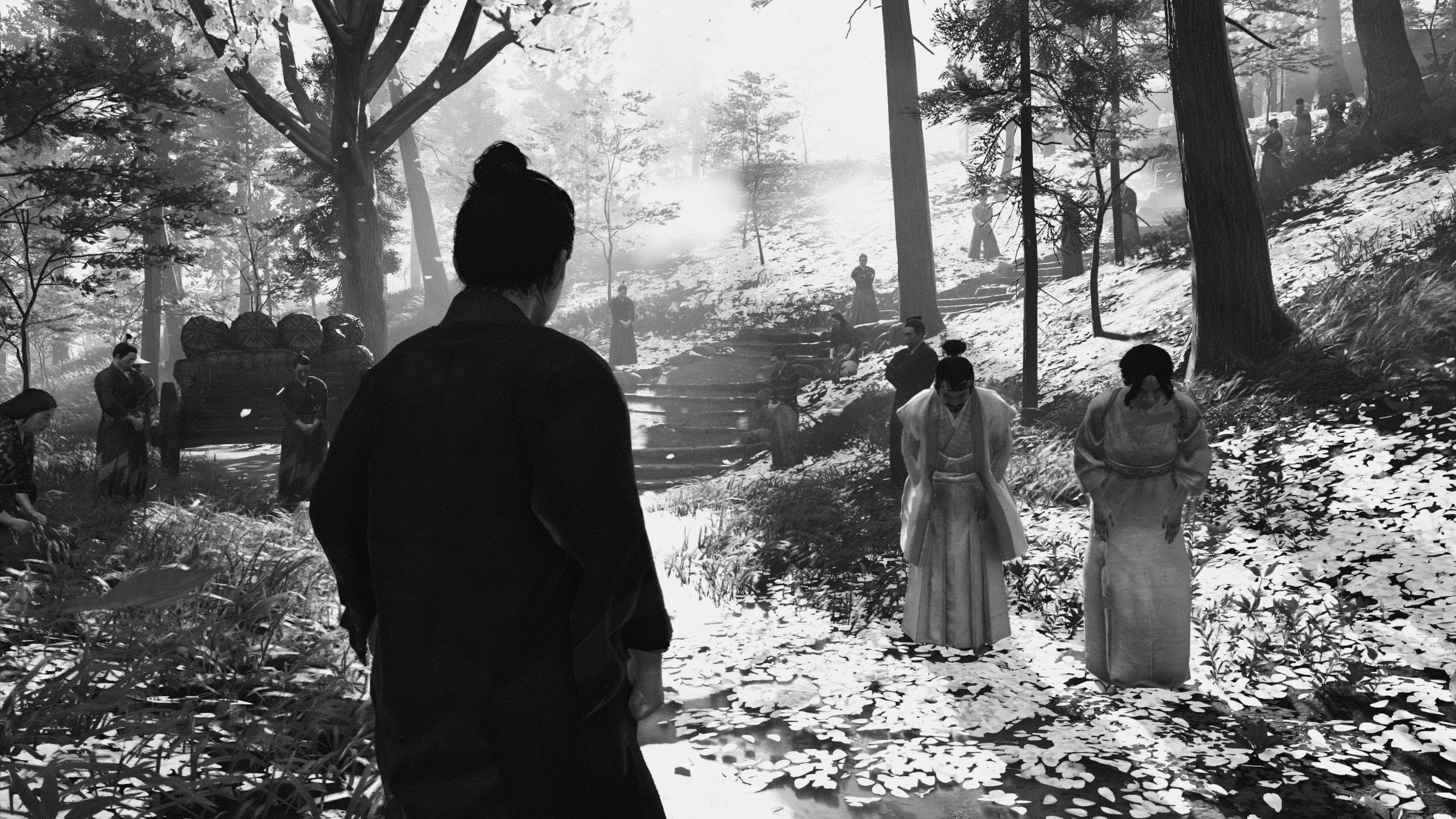
Visually Ghost of Tsushima is breathtaking.
How the plot is told, and how the characters interact (in terms of scripting) is all incredibly indebted to classical Japanese jidaigeki, and notably the classic black and white samurai movies of the 1950s and 1960s.
The dialogue, how the cut scenes are shot, the mission stories and more all, at the very least, evoke memories of classics like Yojimbo, Sword of Doom, Three Outlaw Samurai and Seven Samurai, and being perfectly honest that is greatly to this game's credit.
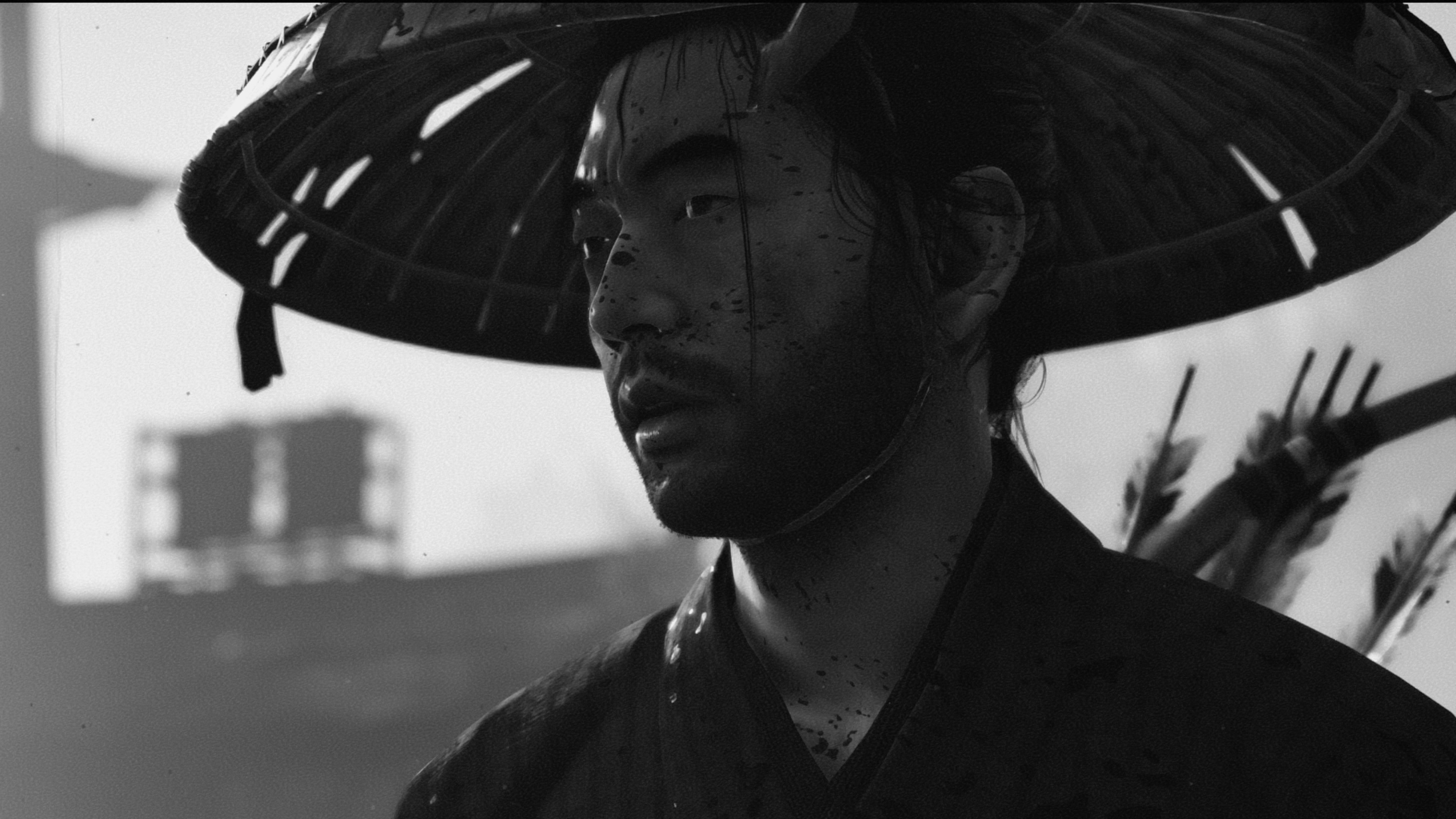
Extra care and attention has gone into character's facial animations in cut scenes, adding to the immersion.
Characters speak as you would expect them to, think as you would expect them to in that time and that situation, and the game benefits as a result in terms of in-world believability and immersion.
I was particularly impressed with how Ghost of Tsushima explores the cultural mindset of feudal Japan and its strict codes of combat and honour.
This game makes you feel like a samurai, both in terms of how you would fight but also how you would think, and that is a great, transcendental accomplishment.
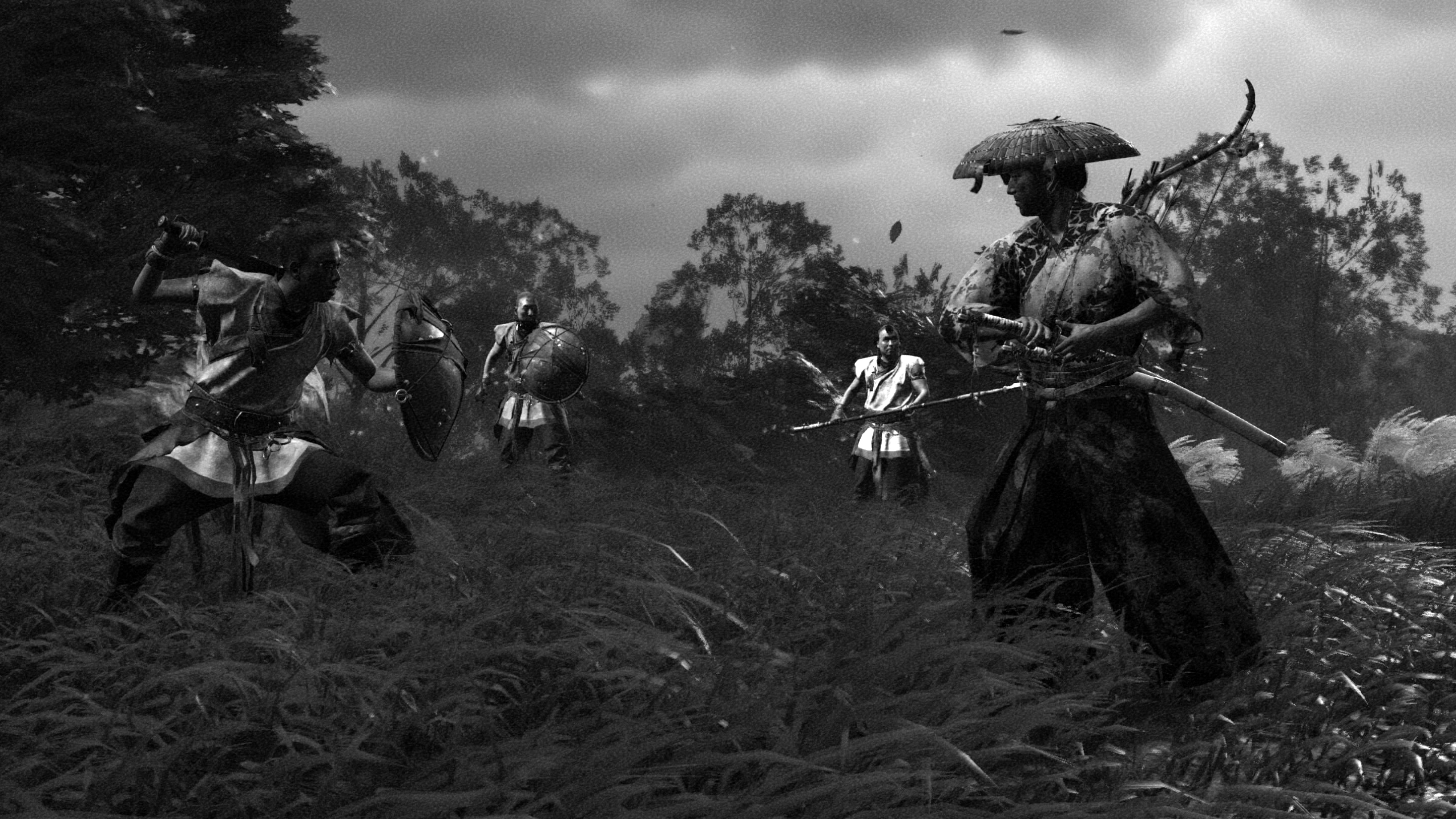
One cut is all that stands in the way of death.
Ghost of Tsushima review: graphics and gameplay
Visually Ghost of Tsushima is one of the most beautiful games I've ever played, and I say that even after playing the game in Kurosawa mode. The engine itself is nothing special, but the art style and authenticity poured into the textures, assets and environment is just first rate and, along with a stunning soundscape and musical score, make inhabiting the virtual incarnation of Tsushima a pleasure.
Sucker Punch has also clearly spent a lot of time animating cut scenes, with character faces especially really communicating their thoughts and feelings. It just makes the immersion in the world and plot that much more believable and intense, which when you're playing out an epic jidaigeki plot is just perfect.
Button mashing in Ghost of Tsushima will get you dead, fast
The best way I can describe the gameplay in Ghost of Tsushima is like a cross between Assassin's Creed, Nioh and Tomb Raider. In many ways it reminded me of Star Wars Jedi: Fallen Order, too, as it shares that game's quite forgiving exploration and platforming with its harder-side-of-normal combat and strong narrative.
To be clear, the game is open world and exploration is easy and rewarding, with the island of Tsushima more or less explorable without gameplay blocks. There are acts in the main story, and some of these need completing before certain areas of the island are accessible, but on the whole if you can see a thing then you can walk, run, ride or swim to it.

Visiting mountain top shrines will bag you progression upgrades.
Exploration is built into the game, too, in terms of progression. Like in Assassin's Creed, for example, you can hunt out and honour shrines and temples for various bonuses, while certain landmarks will reward with new gear like sword kits or armour.
Traversing the landscape is basic but effective, with Tomb Raider-style ledge climbing, passage squeezing and rope swinging getting you round the lion's share of more vertical environments. There is also a nicely implemented climb under building's struts mechanic, which is great for evading enemies when needing to be stealthy.
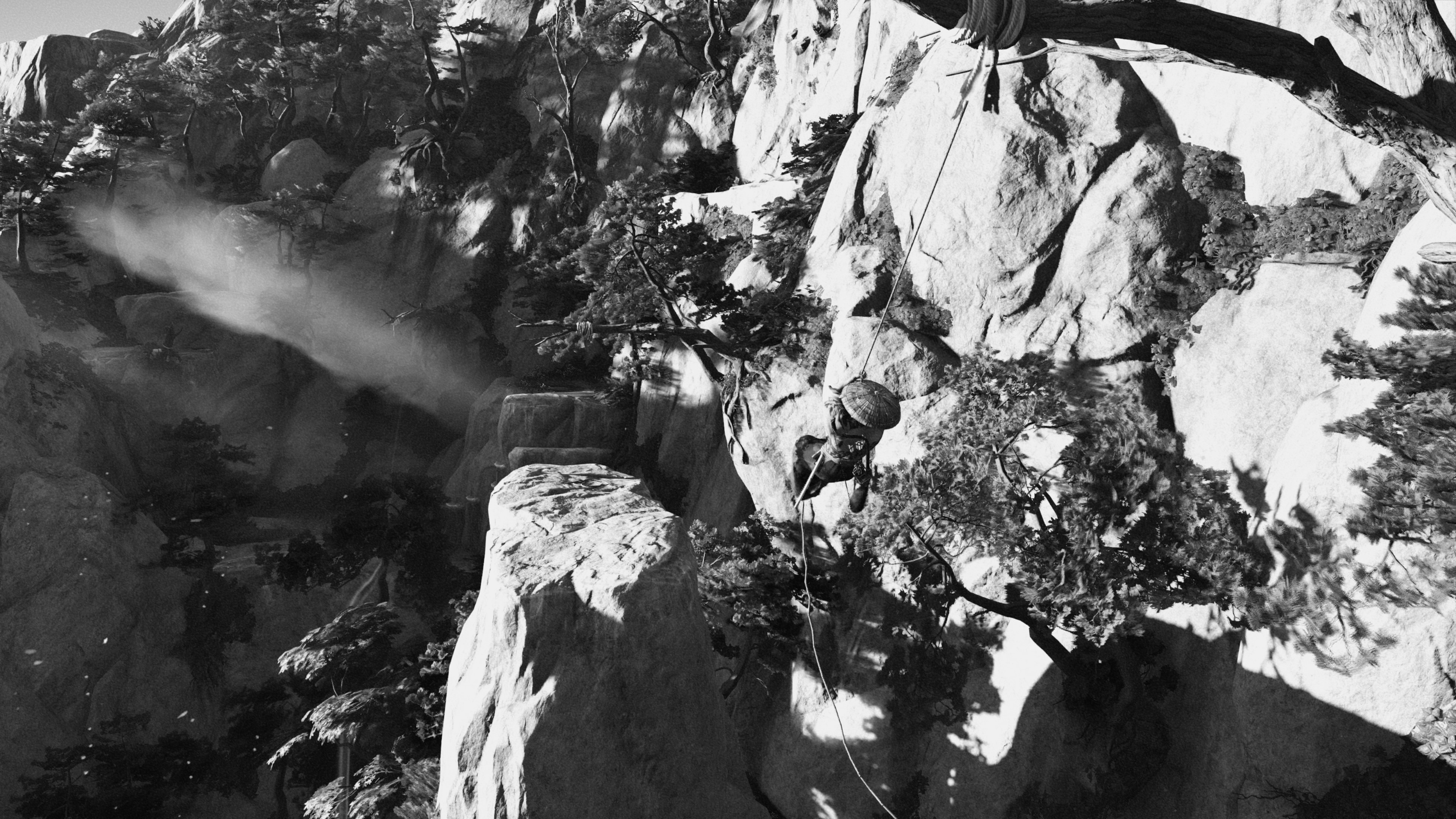
As in Assassin's Creed, your horse (which you get to choose and name near the beginning of the story) is summonable out of combat with a whistle and makes traversing the environment much faster than on foot, where you only have limited stamina to run continuously.
Navigation is handled really, really well in Ghost of Tsushima, too. Mark a destination on your map and by simply swiping on the controller's touch pad, a 'guiding wind' subtly shows you which way you need to go. This really sums up this game's commitment to make the gameplay as natural as possible, with a minimal hud (which can be also basically turned off entirely if desired) also aiding immersion.
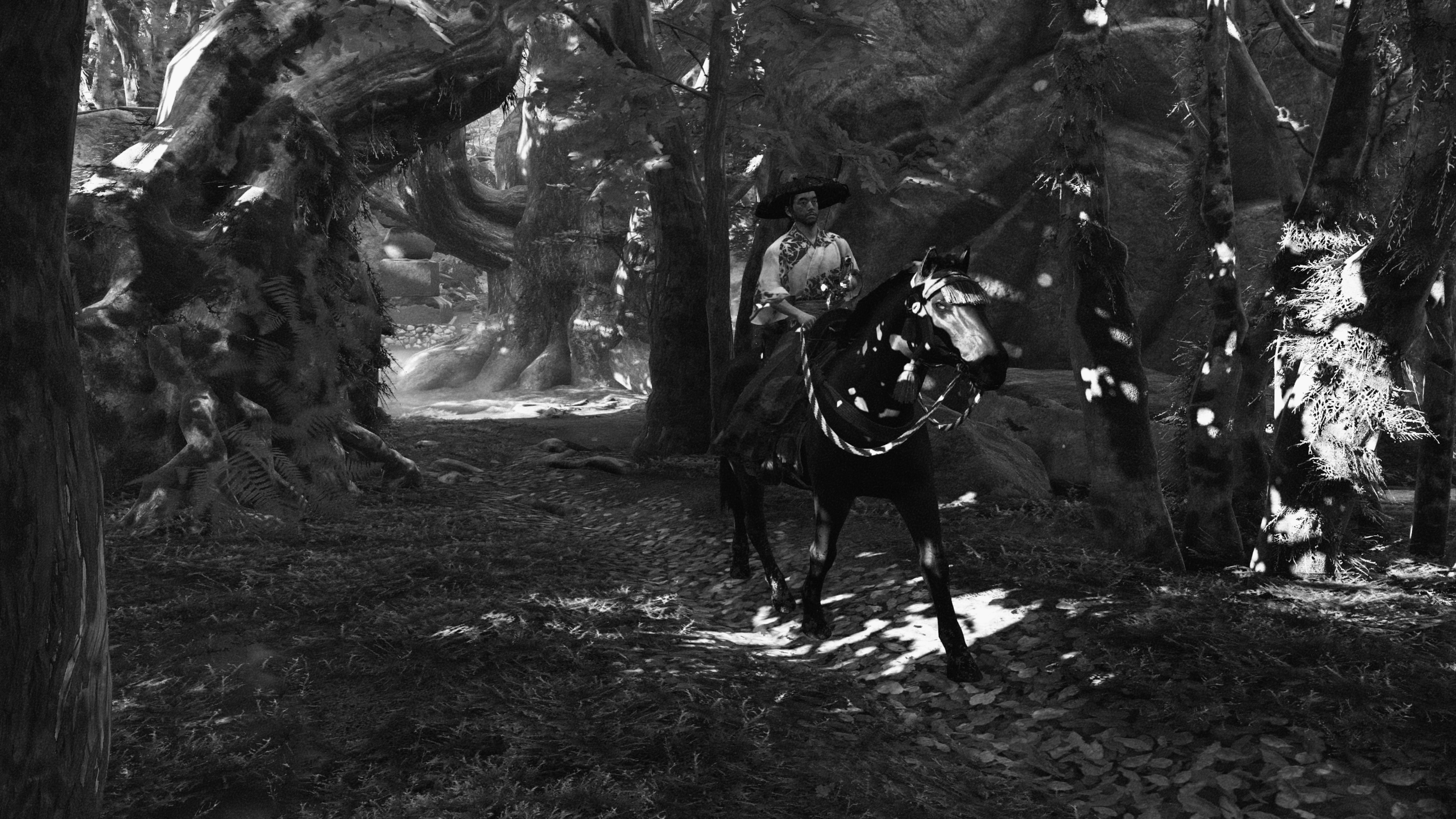
I called my horse "Kage", which means "shadow" in Japanese.
But while exploration is easy and forgiving (it is really hard to get lost, unsuccessfully scale a shrine, or fall to your death), combat is far from that.
Button mashing in Ghost of Tsushima will get you dead, fast. The game's combat is composed on three things, hand-to-hand combat with swords, ranged combat with bows, and then assassin combat, which includes insta-kills up-close as well as more ranged abilities like black powder bombs.
Sword play mechanics involve light and heavy strikes, blocking, parrying and dodging, as well special moves, which consume some of your "resolve" meter. Sword combat also involves one of four stances, which each have strengths and weaknesses against certain enemy types. Think a looser version of the combat in Nioh.
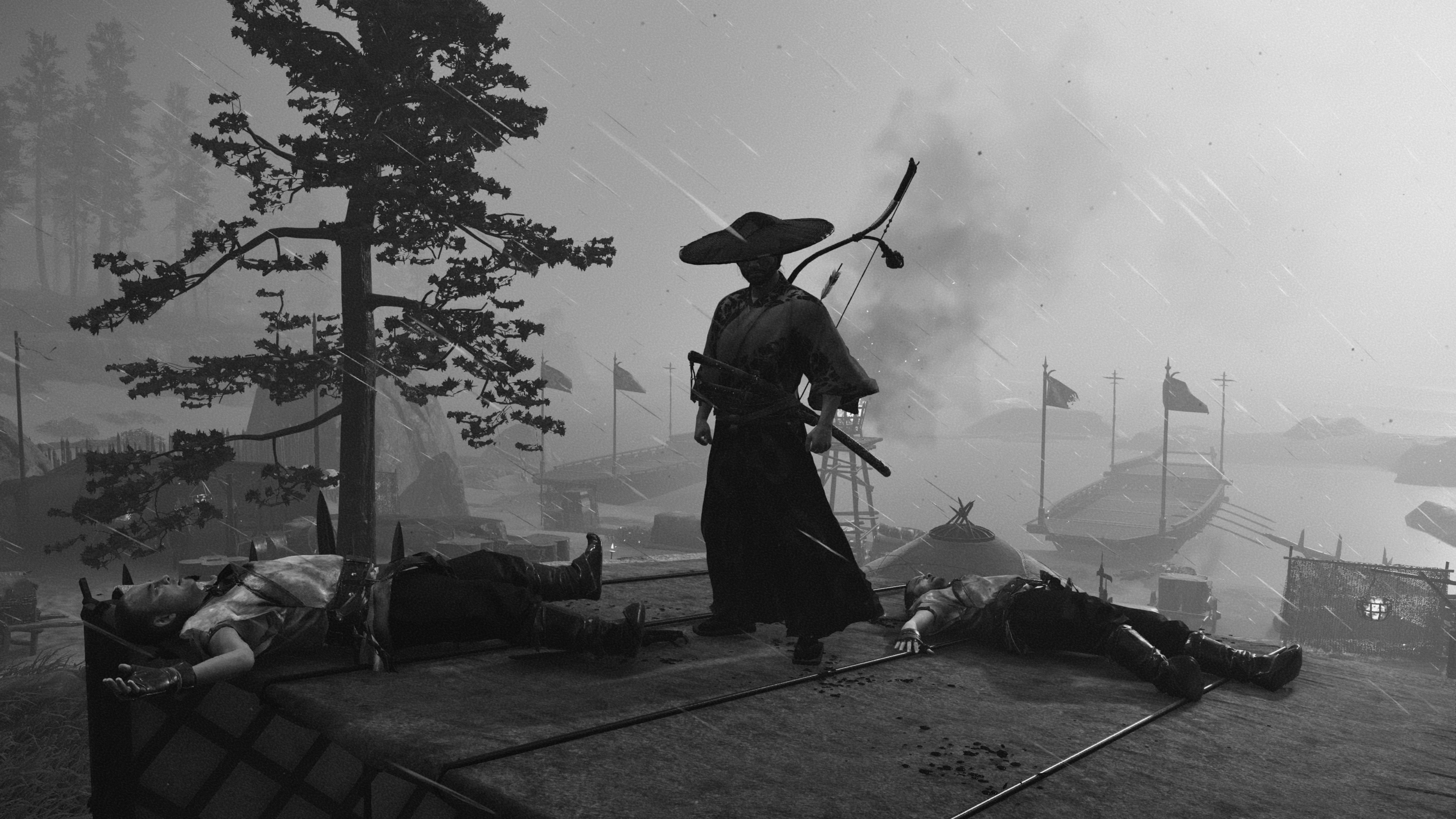
Jin liberating a ship yard from the Mongols.
Fail to adequately use your weapons correctly and you die. I am sure that most players will find that, before the prologue is even out, they will find themselves bleeding out. And that is a good thing, as when you understand how the combat system works and use it correctly, combat is massively satisfying.
Cutting down Mongols without a blow being landed on you feels incredible when you pull it off, and even when you do get hit, you always get a feeling that it is your lack of discipline or timing, rather than the game being horribly unfair.
Cutting down Mongols without a blow being landed on you feels incredible
To the game's credit, it is very good at holding your hand initially, explaining which stances do best against which enemies, and when and how to parry or dodge certain attacks.
Like in Assassin's Creed, enemies will attack you with two types of attacks, standard ones which can be easily blocked or parried (like many games, parrying is about timing, with a perfectly timed block opening the enemy up for punishment), as well as glowing attacks, which at least a the start of the game cannot be parried.
Sword combat therefore is about reacting to enemy attacks correctly, as well as striking at the right time and, often, with the right stance.
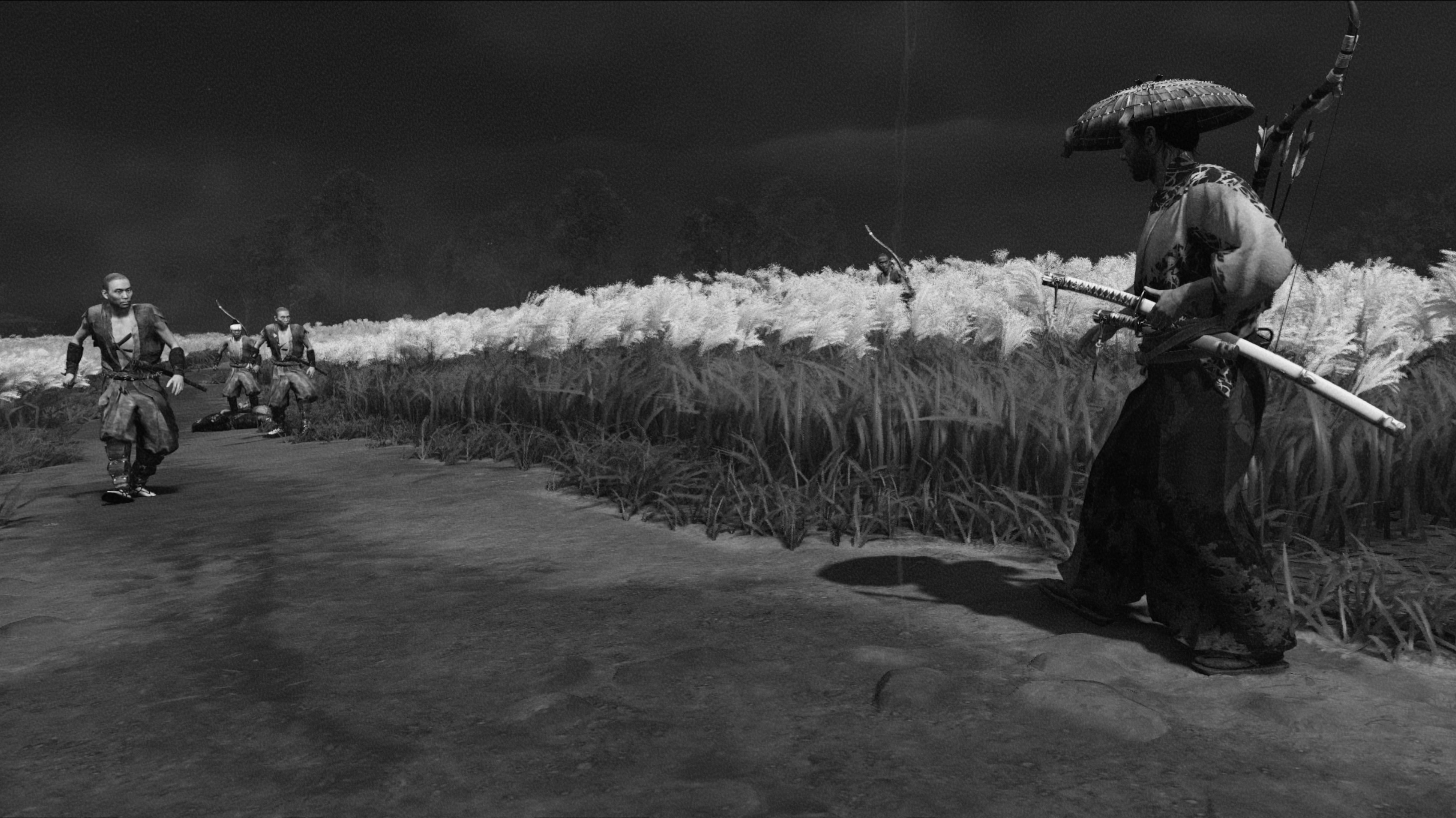
Standoffs in Ghost of Tsushima are tense and require an iron nerve.
Lastly, on sword play, there is one more mechanic that players will need to master – standoff duels.
Throughout the game there are times where, if so desired, the player can call out enemies at the start of a fight to take part in a standoff duel. This is the classic man on man quick-draw fight to the death that anyone who has watched a classic jidaigeki will be familiar with (think Sword of Doom or Seven Samurai), and involves squaring directly off against an enemy.
Strike just as the enemy moves and you will annihilate him in one blow
These confrontations work by the player holding down the triangle button and then only releasing it just as the enemy moves to attack. Move too slow and you get left in a really bad condition and surrounded by enemies that you then have to fight off normally. Move without the enemy moving and you get struck. Move when the enemy feigns to move and you get struck.
However, strike just as the enemy moves and you will annihilate him in one blow (ikken hissatsu), and depending on how advanced you are in terms of character progression, multiple others are then easily dispatched. Suddenly that group of six Mongols is only 3.
These standoffs are genuinely tense and adrenaline pumping, as one wrong move can be the difference between a glorious victory or a bloody death.
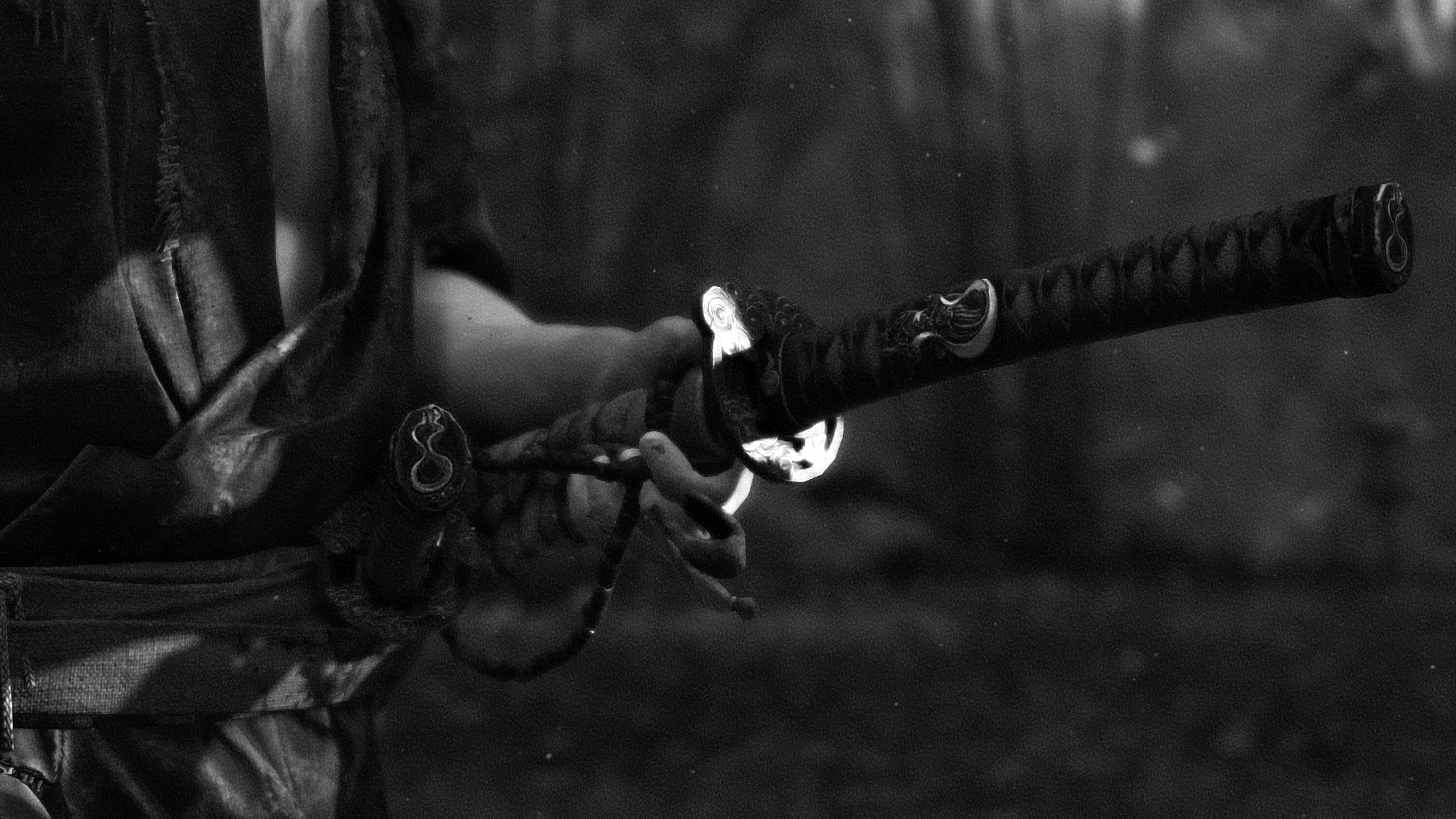
Before every duel you get all the classic Kurosawa shots, including the mandatory freeing of the blade from its saya (scabbard).
Ranged combat works with bows and, without going into too much detail, plays like any bow mechanic you've experienced over the past 5 years. There's a half-bow for closer ranged combat, and a long-bow for zoomed sniping. There's also various different arrow types, too, including flaming and explosive varieties.
In terms of assassin combat, which you will need to use to truly become the "Ghost of Tsushima", you need to remain unseen and then strike from the rear or from the air. This part of the game is massively indebted to Assassin's Creed and plays out in an incredibly similar way.
Distractions like wind chimes can be used to lure enemies to spots for a stealthy dispatch, kunai throwing knives can be used to stagger or finish off stragglers, and smoke bombs can be detonated for when you want to make a stealthy escape or approach. Naturally, you can also pounce on enemies from an elevated position, too.
Every time you kill one of your Mongol enemies with an assassination your resolve meter is filled, meaning that often it is a great way to begin an assault. You get to thin out the ranks of the enemy troops while also filling your resolve meter, which will come in handy later when hand to hand combat is entered.
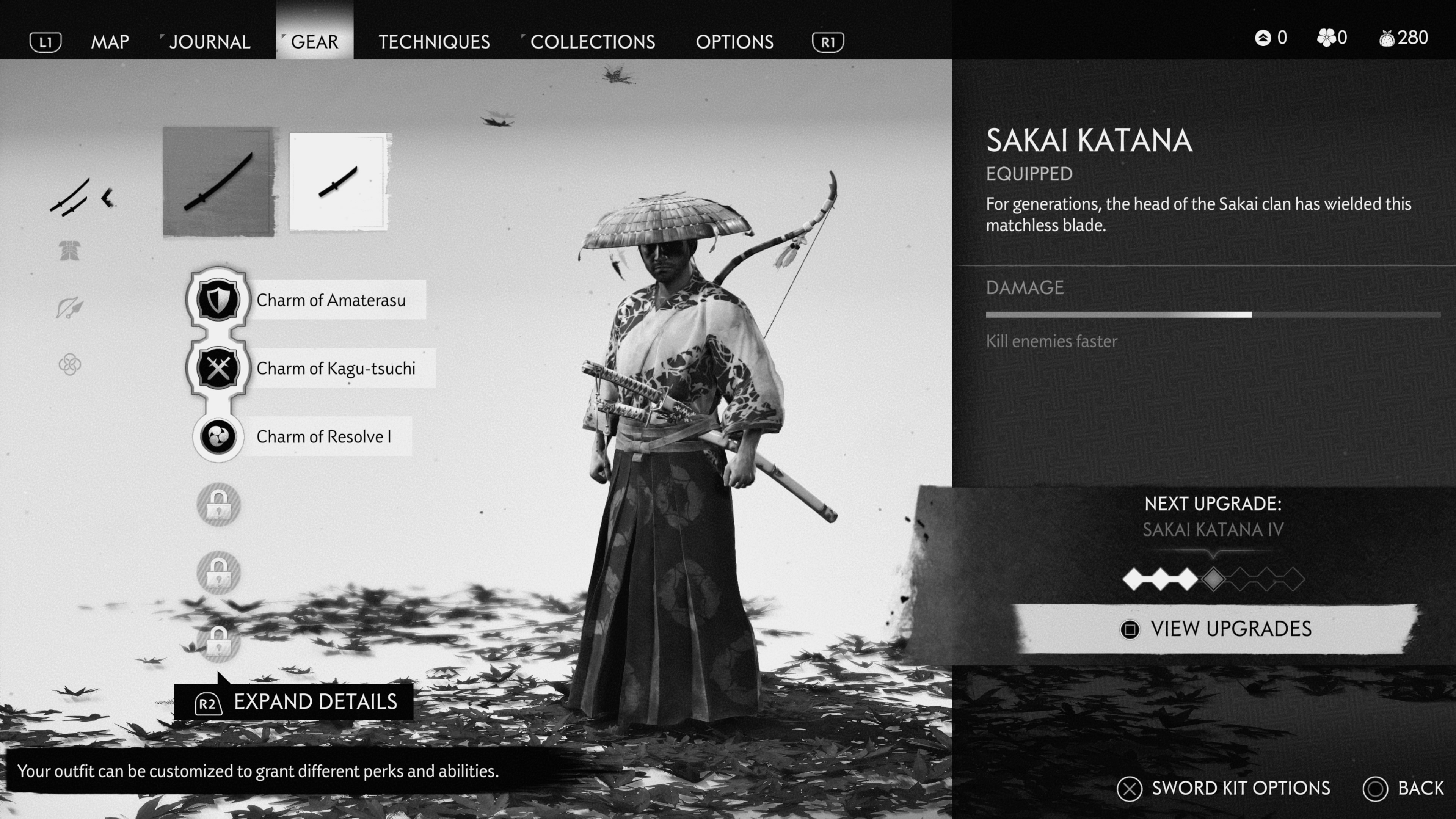
All weapons in Ghost of Tsushima can be upgraded.
Ghost of Tsushima review: progression and customisation
Naturally, progression in the game is dependent on completing missions, both main and side, and then spending earned "Technique" points on various abilities. These abilities are mainly improvements to combat skills, but also can aid exploration, too.
Progression in skills in broken down in various things, but sword play, bows and assassin skills are the main three, with points spent leading to new moves or extra storage capacity for things like arrows and bombs.
Weapons and armour themselves can be progressed by finding or being rewarded with supplies, such as iron, bamboo and silk, among many others. Get enough supplies together and by taking your item to the correct craftsman, such as a swordsmith or armourer, then they can upgrade its quality, improving its stats and its aesthetic look.
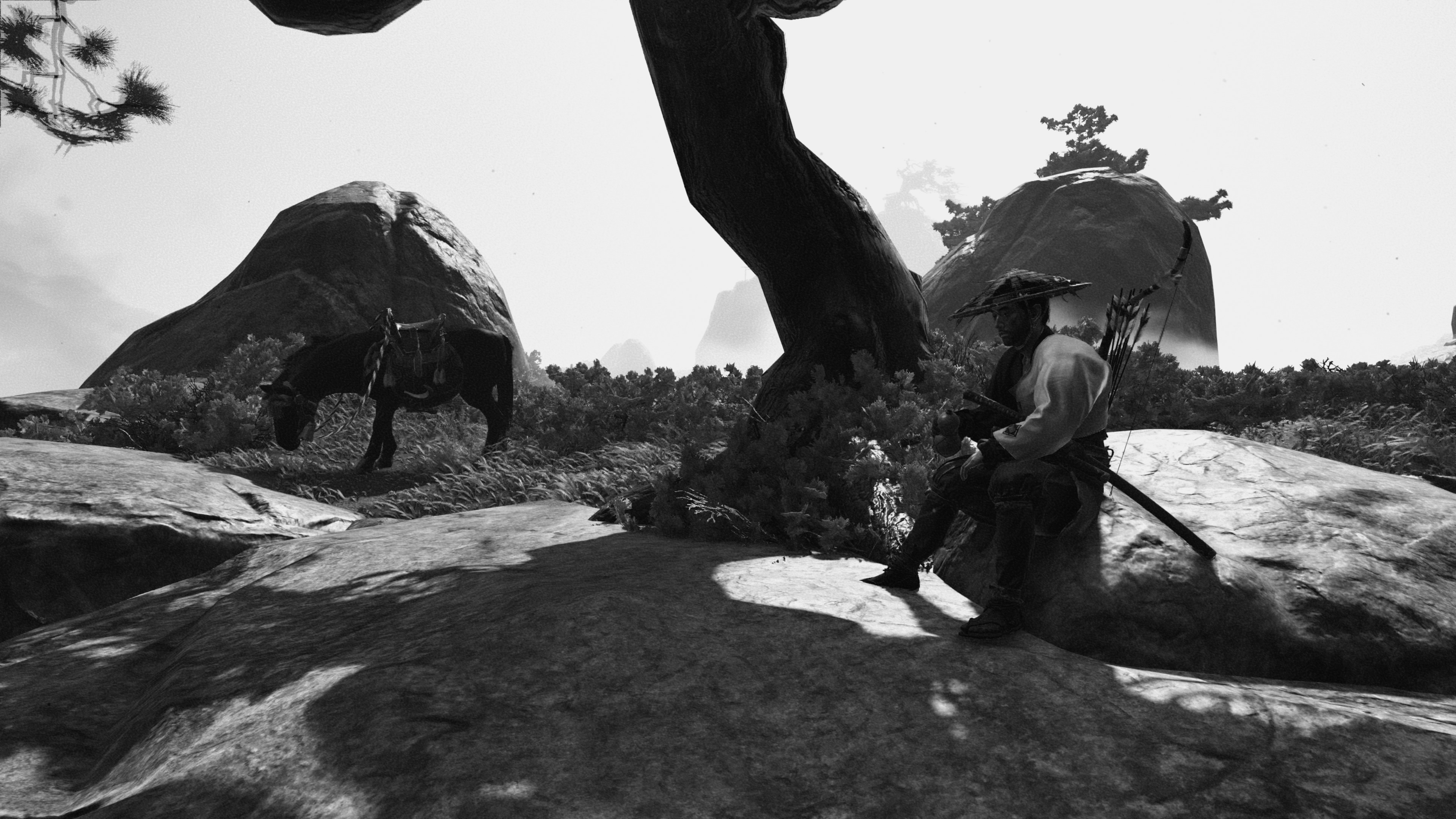
Taking a break post-mission to soak up some of the atmosphere.
There are multiple different types of armour and weapons, too, and these can be customised with various designs and colour schemes. Certain armour types have specific strengths, too, granting bonuses to sword offence for example, or damage taken.
Customisation is also expanded in the game with charms. Charms are often given to the player as a reward for completing a mission and grant bonuses to various things. Equip a charm and the player benefits from its ability.
Charm slots are progressed throughout the game by finding and then honouring Inari shrines, which are led to, naturally, by foxes (the Inari deity is closely associated with them). Find a fox hole on the island and the fox will lead you to a shrine. Find enough shrines and you'll unlock another charm slot.
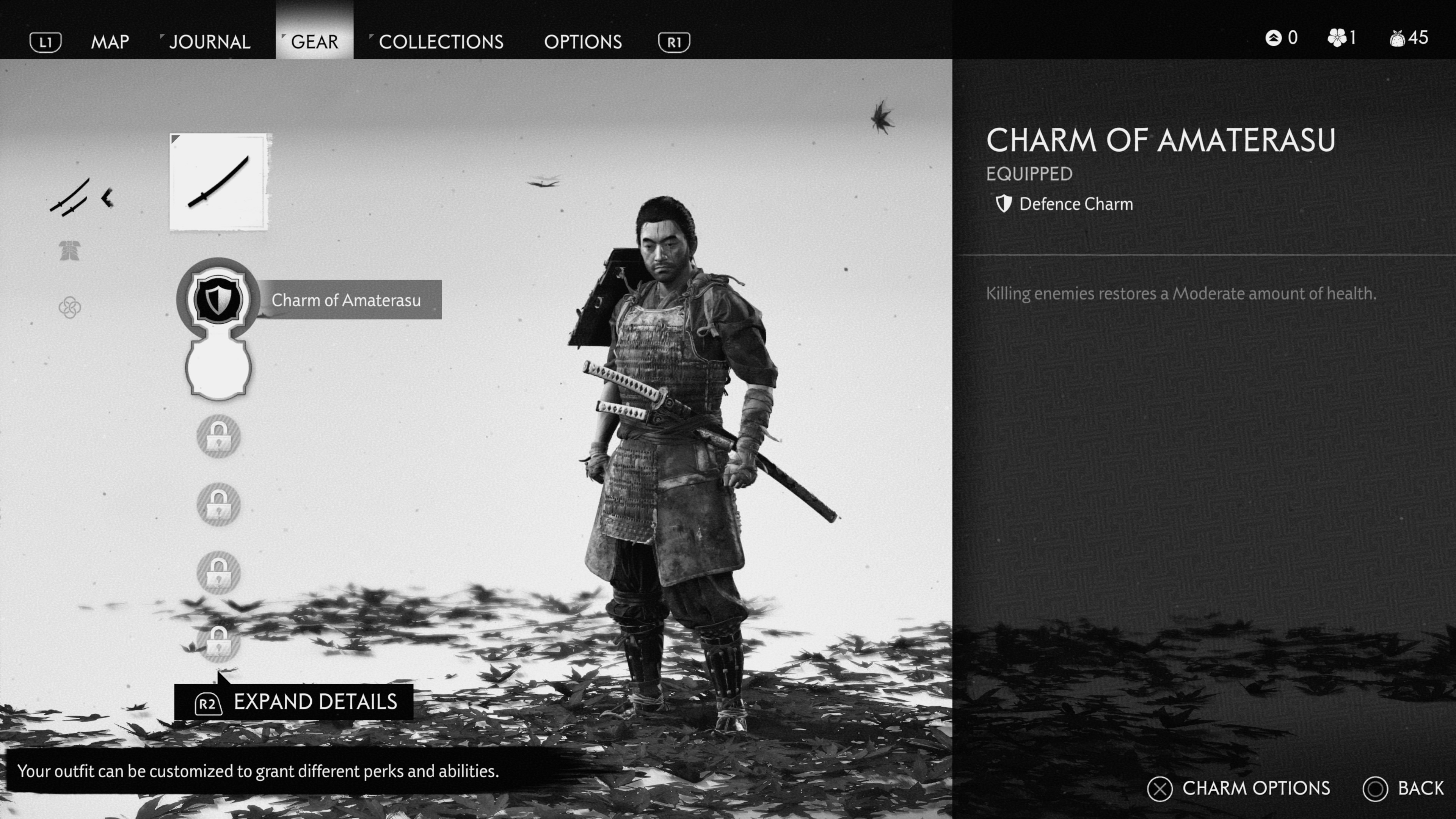
Charms grant small but welcome bonuses. Unlock more charm slots to enable potent charm combos.
In terms of quests themselves progression is broken down in to major quests (which advance the main story), or minor quests, which are either NPC-story tied or more disposable one-off varieties. The NPC stories are interesting and tell evolving tales over a series of missions, while the one-off ones are short and once complete are done with in terms of story.
On top of these missions, there are also many liberation quests where the player has to, for example, free a village from Mongol occupation. These typically reward the player with resources and involve cutting down the enemy troops as well as its leader, which are like semi-boss characters.
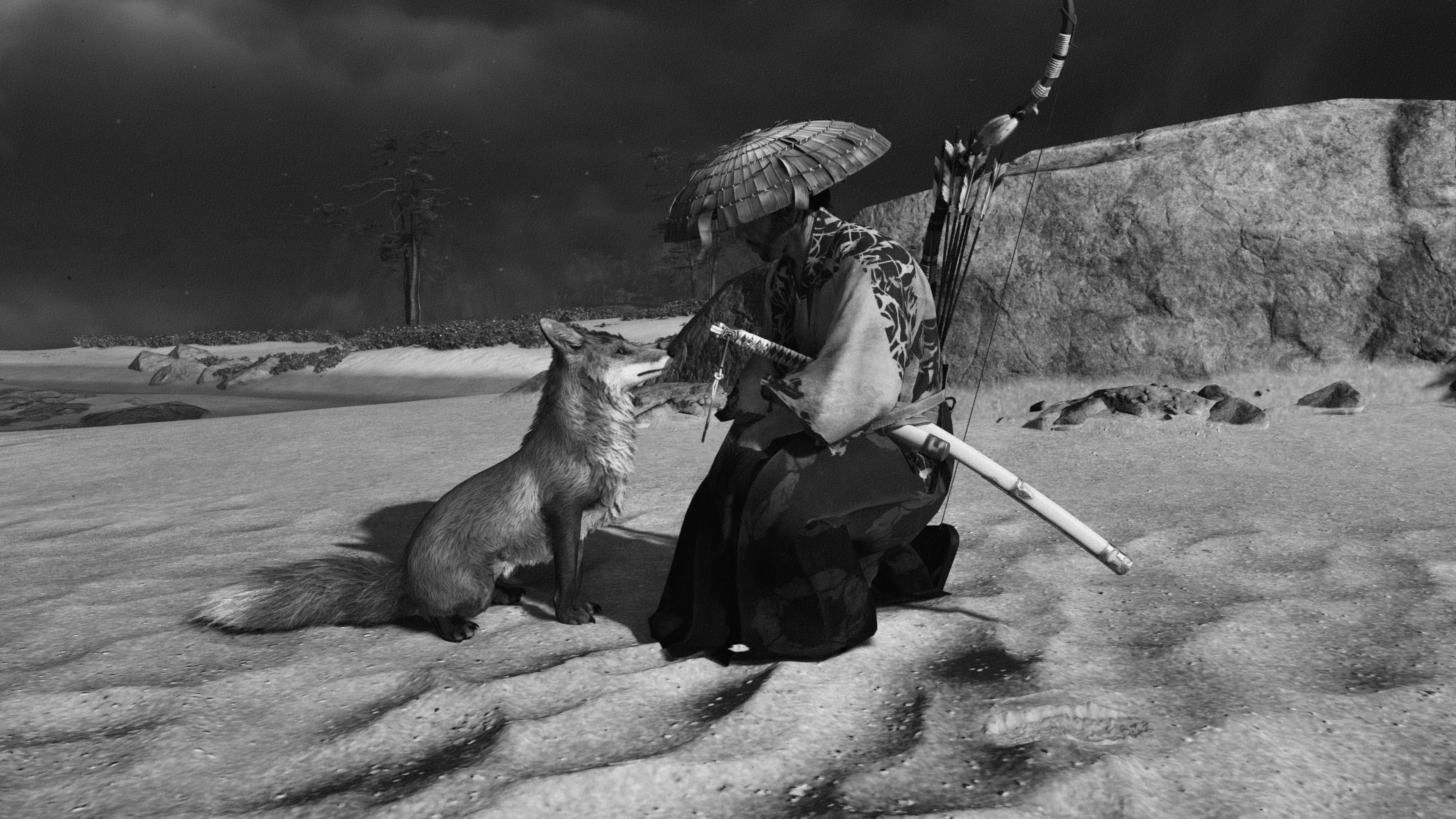
These foxes will lead you to Inari shrines, which once honoured will unlock more charm slots.
And finally on progression, it is by observing or cutting down these Mongol leaders that the player can unlock more stances, which considering they deliver such large benefits when fighting certain enemy types, seems a no-brainer.
Because, in terms of progression, this game essentially unlocks ever more fluid ways to not just attack your enemies or defend against them, but also how to transition between them.
For example, before unlocking a stance that is great against spear men, the only safe option to take them down is to dodge and then strike. With the stance unlocked you have far greater offensive ability, allowing you to strike first in many circumstances.
This stance system reminds me very much of Nioh, and is equally rewarding if used correctly.
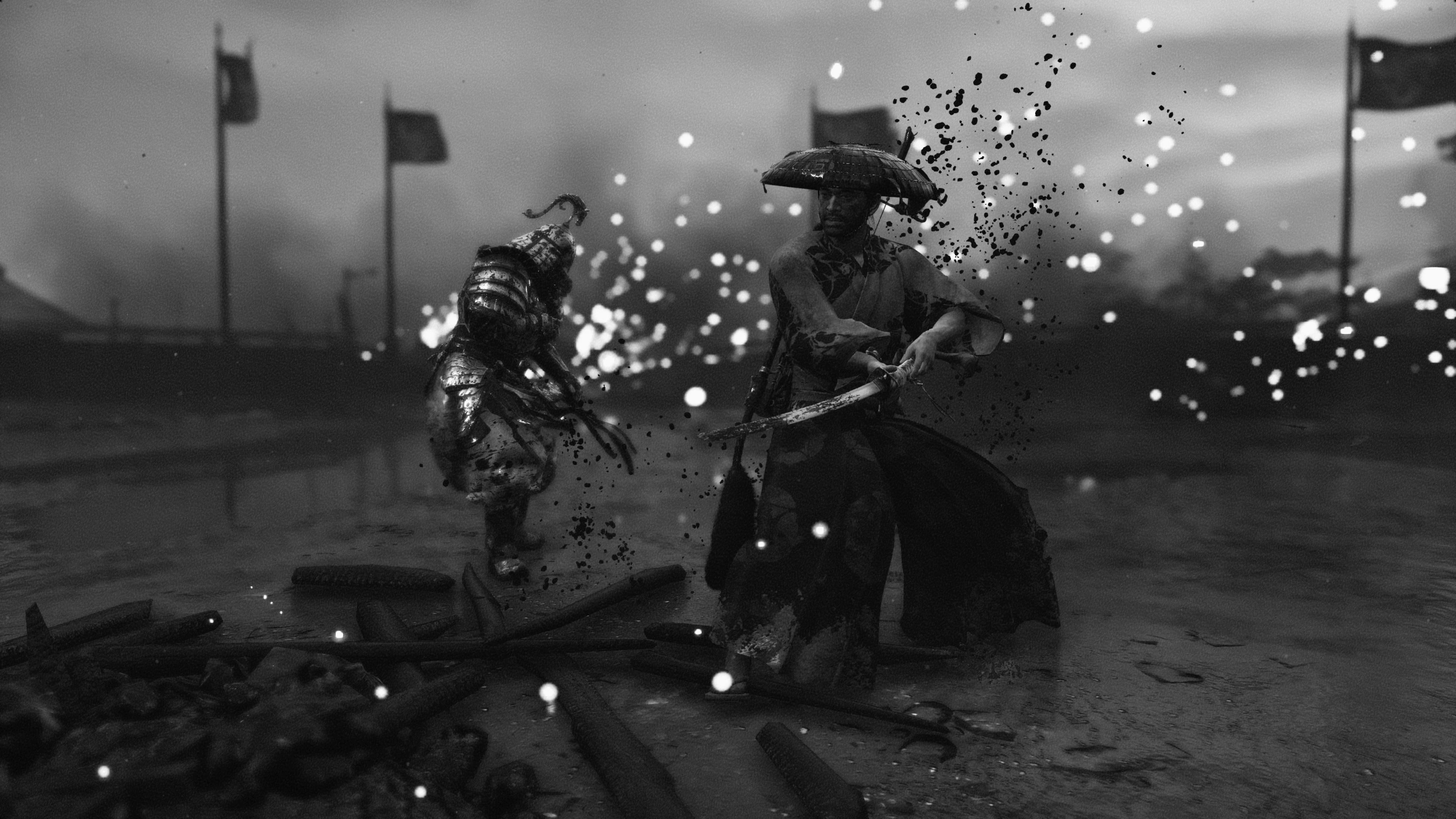
A duel ends with a Mongol leader's arm dismembered in a shower of blood.
Ghost of Tsushima review: verdict
I hope my Ghost of Tsushima review has explained, at least in part, why I rate this game so highly.
One of video gaming's great strengths is that it can, when done well, really empower people by letting them become another character. Frequently these characters have super powers and live lives that are far divorced from our own, which makes escapism easy and attractive.
Ghost of Tsushima does this in one of the strongest, most classy ways I've ever seen, and it does it while maintaining a sense of the real world at the same time, too.
Ghost of Tsushima is a masterpiece
Jin, as the hero, is not unstoppable and laden with demi-god super powers, and he (as well as the other NPC characters) don't talk and - crucially - think out of their time either, which is something that most games never get right.
Instead Ghost of Tsushima primarily empowers through immersion and commitment to authenticity, with bloody and brutal combat and feats of daring do a secondary consideration.
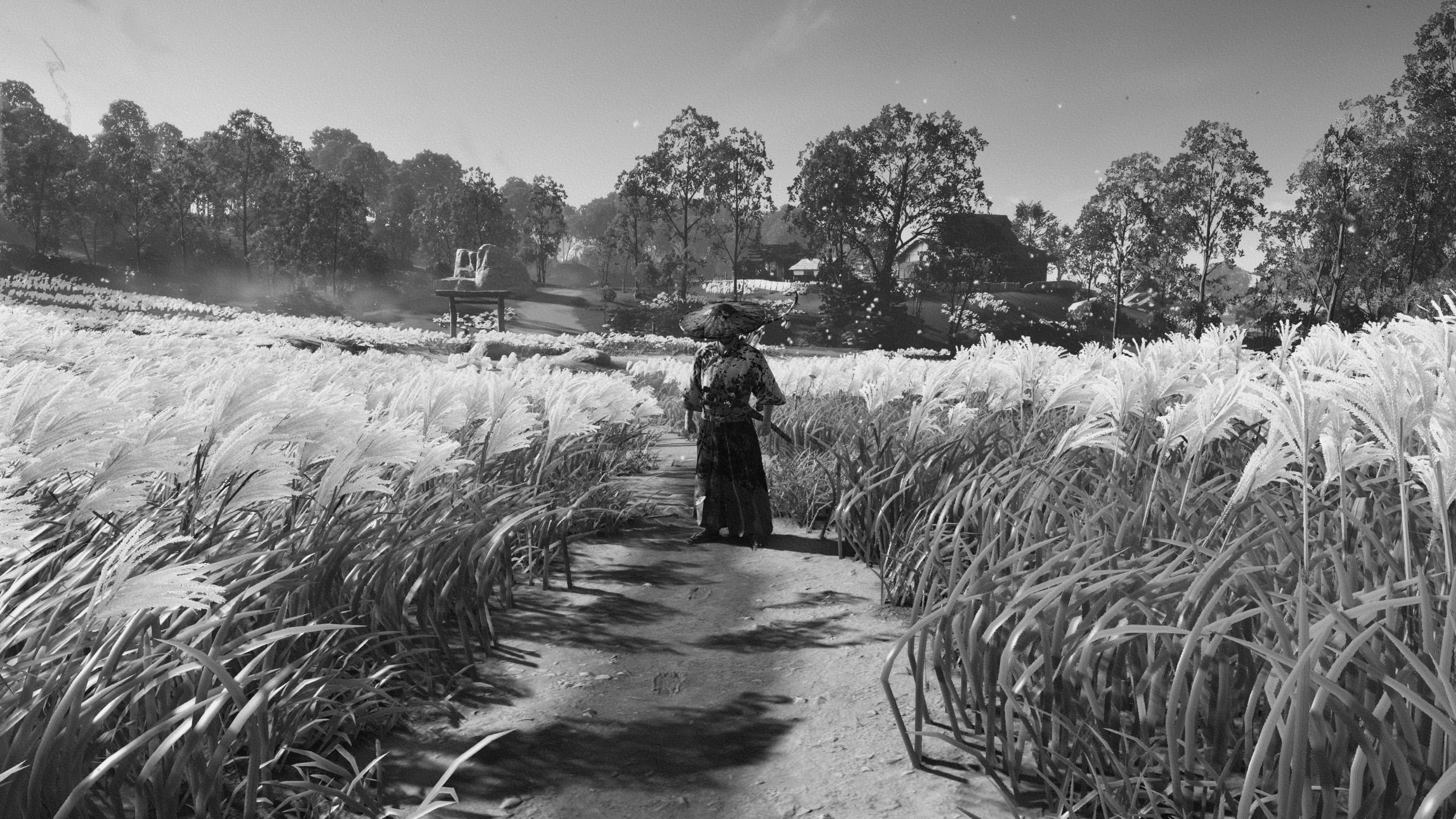
Ghost of Tsushima is a masterpiece. A mature, thought-provoking open-world action adventure with tremendous class.
This love letter to classic samurai movies therefore ends this generation for Sony, in my mind, in the absolute best possible way.
Ghost of Tsushima is testament to the fact that you can make a thoroughly entertaining video game, and one which empowers the gamer in many wondrous ways, while also delivering on mature themes and keeping characters complex and their motivations real-world grey.
It also carries many positive messages that I feel we need now in the world more than ever and, aptly, brings to mind the famous Kambei Shimada quote from Kurosawa's own masterpiece, Seven Samurai:
"By protecting others, you save yourself. If you only think of yourself, you’ll only destroy yourself."

Rob has been writing about computing, gaming, mobile, home entertainment technology, toys (specifically Lego and board games), smart home and more for over 15 years. As the editor of PC Gamer, and former Deputy Editor for T3.com, you can find Rob's work in magazines, bookazines and online, as well as on podcasts and videos, too. Outside of his work Rob is passionate about motorbikes, skiing/snowboarding and team sports, with football and cricket his two favourites.